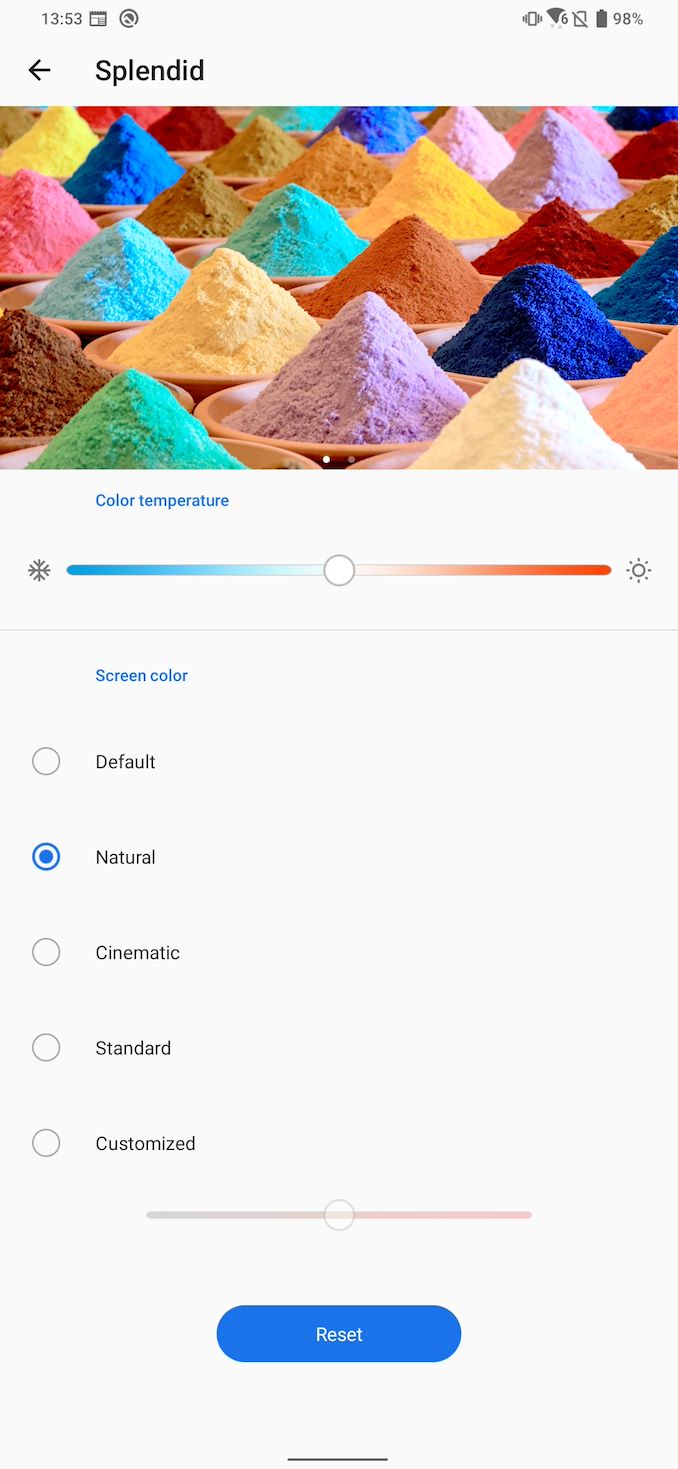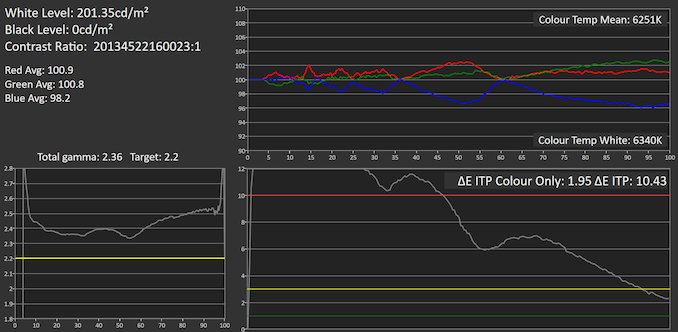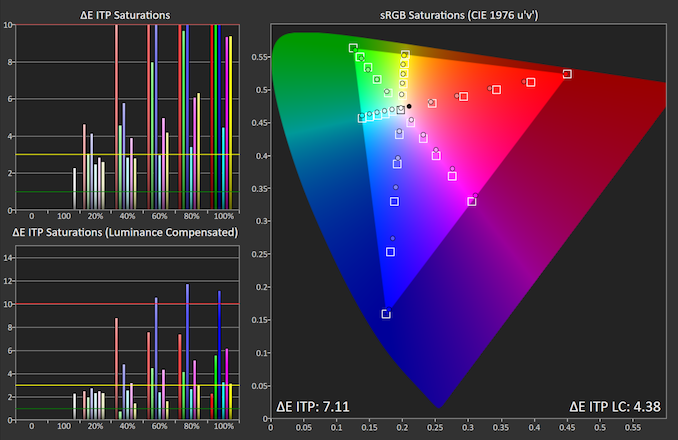The ASUS ZenFone 7 Pro Review: The Triple Flip-Camera
by Andrei Frumusanu on September 1, 2020 3:00 AM EST- Posted in
- Mobile
- Asus
- Smartphones
- ZenFone 7
- ZenFone 7 Pro
Display Measurement
The display panel of the ZenFone 7’s is made by Samsung and comes in at a resolution of 2400 x 1080 and a 90Hz refresh rate. There’s nothing too much out of the ordinary for the specs, and represents the middle-ground of what we should expect out of a 2020 smartphone.
Calibration-wise, we see the same display profiles page as on the ROG Phone III, giving us a few different display profiles to choose from. I noted that out of the box the ZenFone 7 was quite blue on its default profile, however switching over to the “Standard” profile will give you the most accurate sRGB colour profile with colour temperature near a 6500K target.
We move on to the display calibration and fundamental display measurements of the ZenFone 7 Pro screen. As always, we thank X-Rite and SpecraCal, as our measurements are performed with an X-Rite i1Pro 2 spectrophotometer, with the exception of black levels which are measured with an i1Display Pro colorimeter. Data is collected and examined using Portrait Display's CalMAN software.

In terms of brightness, the phone reaches 450nits in maximum manual mode, while boosting up to 652nits at full-screen white (100% average picture level). It’s very respectable and gives good legibility in sunlight, albeit a bit behind some of the newer generation displays from the competition.
In the standard profile, colour temperature on my ZenFone 7 Pro sample was a little warm as whites came in at 6340K and average colour temperature over the levels range ended up at 6251K. I actually noted this out of the box, and I preferred to use the colour temperature slider to slightly give cooler tones. We’re still measuring and publishing the default settings for the article though.
In terms of gamma, the ZenFone 7 Pro exhibits the same characteristic as the ROG Phone III in that the device is targeting a 2.4 target rather than the standard 2.2 target for typical web content and the sRGB profile. This results in slightly darker tones in colours.
The saturations accuracy in the sRGB gamut weren’t as good as on the ROG Phone III. Beyond the colour temperature and gamma offset, the ZenFone 7 Pro also showcased some off-hue colours in the magenta range, with some undersaturated reds and blue mid-levels.
The Gretag MacBeth test fared a little better, although unlike the ROG3 where the errors mostly lay in the luminosity of the colour patches, the ZenFone also has a stronger off-target saturations, mostly being undersaturated.
ASUS’s marketing claims of some unspecified deltaE of below 1 however are quite far-fetched as beyond the non-standard gamma you also have quite a bit of off-target colour temperature as well as saturation mishaps. I wish vendors would stop proclaiming specifications which just don’t hold up in practice.
Overall, the display of the ZenFone 7 Pro is pretty adequate and well in line with competing devices at this price range.
















31 Comments
View All Comments
JfromImaginstuff - Tuesday, September 1, 2020 - link
Seriously, doing away with the headphone jack in exchange for 5G. Might as well go with Samsungs.yu - Tuesday, September 1, 2020 - link
Yeah they say 5G antennas are small, sometimes they omit the fact that you need more than a dozen of them.melgross - Tuesday, September 1, 2020 - link
You need from three to five, depending on whether you’re using sub mm bands or not, not dozens.Quantumz0d - Tuesday, September 1, 2020 - link
It's 100% b.s LG V60 and Sony Xperia Mark II both of them are 5G and LG even has full U.S band support with mmWave technology as well and has a superior Audio performance from the standalone RFI shielded high end ESS9219 DAC chipset (ESS9218P was being featured in LG phones from V30 and up) and both of them have IP68 rating along with Qi charging too. The fact that Note 20 gets a full blown Silo for the S-Pen makes so fucking ground for these lying bastards. Removing jack is saving pennies and forcing them to buy accessories which also die out due to the Li-Ion technology.5j3rul3 - Tuesday, September 1, 2020 - link
Can anyone describe how to understand the ∆E ITP and ∆E ITP LC value?I did use ∆E 2000 with Gamma 2.2 for long time, but even searching in google, the data just saying about Rec.2100, EOTF, PQ, HLG and ITU-R....
I knew ∆E ITP is a part of Rec.2100 HDR...but, the info I really want to know is the relationship between ∆E ITP (LC) and real world.
∆E 2000 < 1:Great and almost perfect
∆E 2000 < 2:so hard to see the difference and it's good enough for professional users
∆E 2000 < 3:good for general users
∆E 2000 < 5:ok for general users but still has noticebal color difference
∆E 2000 > 7:esay to see the color difference
Can ∆E ITP and ∆E ITP LC use those standards (0 ~ 1 ~ 2 ~ 3 ~ 5 ~ 7 ~)?
Andrei Frumusanu - Tuesday, September 1, 2020 - link
dE ITP is a new standard that takes into account more modern reproduction formats such as HDR. Generally ITP is a little more sensitive than the 2000 standard to colour deviations: https://kb.portrait.com/help/about-deltae-edE ITP LC as I use it in the new reviews is simply a luminance compensated value, meaning that the error value ignores the luminance error and only looks at hue and chromacity. This makes sense for example in this review here as the ZenFone is targeting a 2.4 gamma by default, however our measurements are against a 2.2 gamma target. So the dE LC values are always going to be lower since it ignoers that part of the colour inaccuracy.
Under dE ITP of 1 it's imperceptible, under 3 it becomes acceptable when not viewed next to each other, and over 10 means it's horribly wrong.
5j3rul3 - Thursday, September 3, 2020 - link
Thank you @Andrei, the reply is really helpful!!!Now I can read the Calman's color calibration charts and info well based on that very useful knowledge, and easy to judge which device can provide great display quality.
Two more things I was wondering in this article:
1. The devices that Anandtech had reviewed such as Mate 20, iPhone XR, Xperia 1 even Surface Pro or XPS13, will get the updated display quality review based on the new delta ITP (LC) standard?
2. ASUS ZenFone 7 Series has a telephoto camera that has very similar spec to HUAWEI and Honor devices' (OV8856, 1/4.4", 1 um, F2.2, 80 mm{, OIS}, with terrible PDAF). It brings 3X Optical Zoom to ASUS smartphone first time and I'm expecting the 3X OZ camera can shows on ZenFone 7 Pro's review. This will be interesting if we have a comparison between ZF7P, 1+7P, M30P, P30 those who having a 3X OZ camera.....is there any opportunity to see this kind of comparison?
in the end, I really thank to AnandTech's great quality reviews!!!
shabby - Tuesday, September 1, 2020 - link
"This is something that ASUS actively acknowledges as being a deliberate design choice so that that they could fit in more components and a larger battery"Did they forget about the headphone jack?
drexnx - Tuesday, September 1, 2020 - link
>made phone huge for more componentsoh yeah we couldn't throw the 3.5mm jack in there, not enough room. The 5 gees, you know, they take up too much space.
Hamm Burger - Tuesday, September 1, 2020 - link
I thought that the unexpectedly low battery life might be because this phone did mm-wave 5G. Bit no: having dug up the specs, the highest 5G frequency band it can handle is 3.3–4.2GHz.